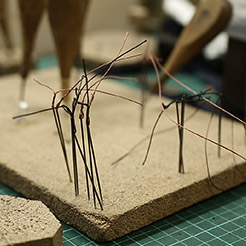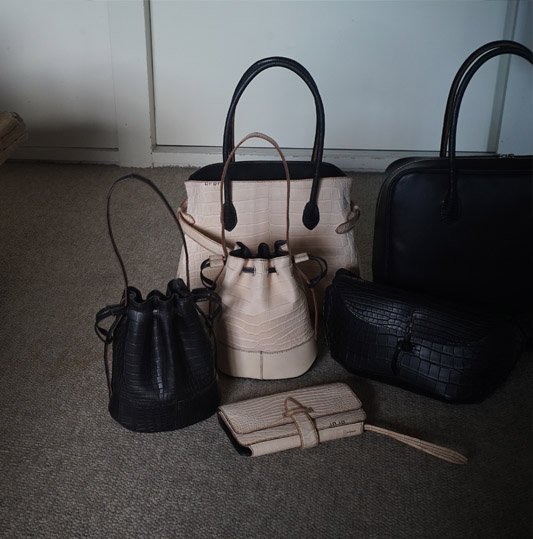Saddler’s work
Artisan work called sellier, which means saddler in French
How come does he make everything stubbornly by hand. And why is it so fascinating. We believe an appeal of the any kinds of works which made by hand is we can feel the maker behind it. The man who used to work at the most high-end luxury production in the world has been making his own here in Japan by French traditional saddler techniques. We are pleased to introduce what we saw and what we’ve learned together with “behind the scene” of his production through all our time spent in the atelier while hearing some speeches by the man who’s normally very quiet.
Origin of sellier
First of all he begins to design final product imaginary in his mind, and then resolve it into all necessary processes as well as the techniques required in order to achieve the completion. This is very important but sensitive work required of techniques, experience and sensibility to imagine all paths to the goal as the completion planning for a few months later. He brushed up imaginary picture of completion clearly by repeating detailed processes many times in his mind, especially for the combination of materials created by galerie a for timeless exhibition.
- Material・selection
- He visits to Japanese crocodile tannery who’s been trusted by many luxury houses represented by Maison Hermes, and there he only selects skins made him convinced through his both hands and eyes based on the quality of finishing, colors and texture. When he explained about materials, he shared us many stories joyfully but at same time, we remember he showed us his concern about sustainability for materials. When we saw and touched his product physically in the end, we did understand the reason of his concern that a truly beautiful materials, which are requisite for his creation, has been getting tougher and tougher to find.
- Design drawing / Pattern making
- Hard paper patterns which have quite a few comments and instructions like codes modified many times for each item. He made decisions on all such occasions for how and which part of crocodile leather he cuts based on the bag design, especially for smaller body crocodile skin which is well known as having beautiful scales and smooth texture. Therefore, he filled in comments, improvements and instructions he found out through production processes on this paper pattern.
- Cutting / Skiving
- He needs to skive each leather panel into appropriated thickness because he only uses leather for entire bag, such as lining, inside pockets etc etc. Therefore, each time when he begun production, he visits to professional Crocodile leather skiving artisan’s atelier who he placed huge trust on, and there he made decisions with skilled artisan piece by piece for the skiving of below the decimal millimeter with checking the quality of leather panel. This is the specific work required own experience and memory of hands about the thickness of leather, but his such obsession for the difference of thickness in below decimal millimeter creates the product with perfect balance to show both meaty and softness, but keeping enough thickness to maintain durability of leather.

Hand work by sellier
Rhythmical sounds of traditional saddle stitching needles up and down echoes in the room. Wooden tool to hold leather parts in worker’s legs to allow him sewing them by both hands with needles. Deadstock 100% linen thread made by French supplier who’s gone already has kept both durability and beauty. Beautiful metal tool for the perforation to sew. He’s discovered all these precious tools in France and kept using them till now. Saddler’s work called sellier is transmitted techniques generation to generation which has developed and matured by European saddler’s represented French one. All tools supported workers to maintain its technique, and very precise detailed work to maximize potential quality of techniques as well as tools. There’s the fact on the basis of his production that he’s spent enormous time on both pursuing saddler’s techniques with tools and obsessive care about the quality.
- Hand sewing
- It’s all made by hand-sewing by Saddle Stitching which gives high-durability by the technique using two needles on both hands. As result of this stitching, its product gets continuously beautiful stitch bit angled toward to sewing direction. While checking the quality of leather step by step, and coordinating the tension of Stitching based on sewing part as well, he sews really slowly stitch by stitch. It’s truly marvelous that Accalmie products are entirely sewn by saddle stitching, even for invisible sewing parts.
- Handwork
- “God is in the details” is a well-known common language anywhere in the world, and the works could touch wearer’s emotion are definitely built under tremendous amount of time and cares for such invisible parts. He glued crocodile panel for exterior with calf panel for interior naturally before sewing, and that's also very important process of production to achieve beautiful result in the end but at the same time it’s essential process to let the handbag live long life together with wearer in the future.
- Touch
- Accalmie’s hand-made handle which simply shows its beauty and quality at first sight is one of strong features of the brand. This handle spontaneously stands up from the body and give you immediate the feeling of security when you hold it. Also, it gives you wonderful sensibility to promise you to get to fit your hands slowly but definitely. He tidies up the edge of stiff leather cord by small knife to prepare using for the core of handle, and then shaves its surface off to bond together with exterior leather. He then hand-sewn it. After pressing the edge as well as stitching by iron tool, he polishes the edge by clear raisin of Acacia tree called “Gomme Arabique”, and the edge came out looking like bark in organic natural color by polishing.


Beautiful products, things being beautiful
Every single leather panel has been cut from the original skin are getting gradually shaped for the completion showing abstract outline by passing through piles of processes. Polished the edge carefully by Gomme Arabique from natural acacia tree has the texture looking like bark, Curves and space for sewing to be created wooden spatula aged by the use, Seam allowance pressed firmly by old iron tool, And beautiful lines on the edge created by tool to add decorative design on the stitch of handles, or straps. Having all these details, his product made us impressed with warm feeling by maker. One day while we stayed at his flat, we witnessed the brief moment he stared at his handbag just completed face to face with silence in the atelier. This is his important ritual. He explained that it’s just an end for one project, but at the same time, it’s the kick-off moment to launch next new production. Through such ritual moment, we could understand more about his concept, attitude for creation, and the meaning of Accalmie. This experience helped us find the connection in between what he likes and what he cares. Moreover, this moment got us to have a think about his labor time for making product. How many products he could produce in this way in his entire life as artisan while having such obsessive cares for the quality as well as the honesty for any single process of limited production in limited time. When we thought about this question above, we believe his work must be more rated high and should be more in the limelight because we are all living in the transition moment to think the true value of creation/work by restriction of Covid infection, and therefore we’d like to present our exhibition to be partly responsible for his creation.

Open gallery
- Gallery opens
- You can see the work on the following schedule. We look forward to seeing you there.
* No appointment is required.
- Open gallery
- 2023.2.10 FRI -2.19 SUN 12:00 - 18:00
- Adress
- 150-0001
Tokyo, Shibuya City, Jingumae, 3 Chome−36−26
Villa Uchikawa 101
※ Please be sure to wear a mask to take care of cough etiquette when you come in the space. Please also use hand sanitizer at the entrance. Gallery staff will wear a mask to welcome you.
Credit
- Special Thanks
- Stephan Laurent
Noriko Usami - Gallery Direction
- Nobuhiko Akiyoshi
- Contributors
- Yusuke shiiki
Roca Onishi
Masakado Nishibayashi
Ahraun Chambliss
Yuko Mori
Shoko Akiyoshi






